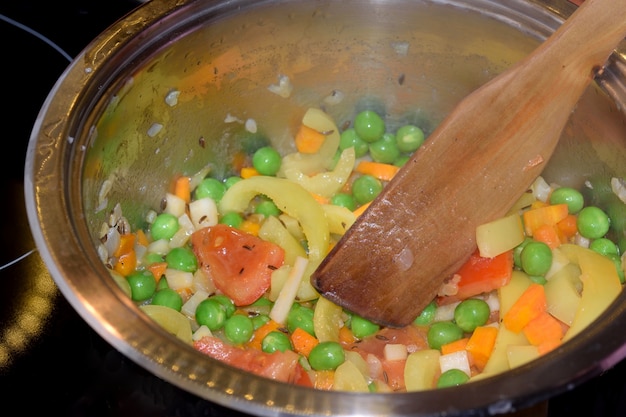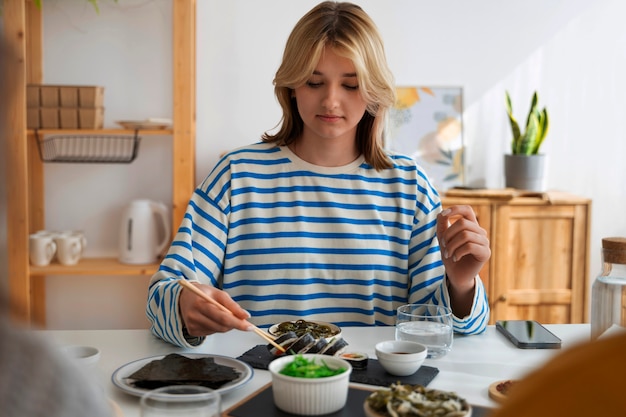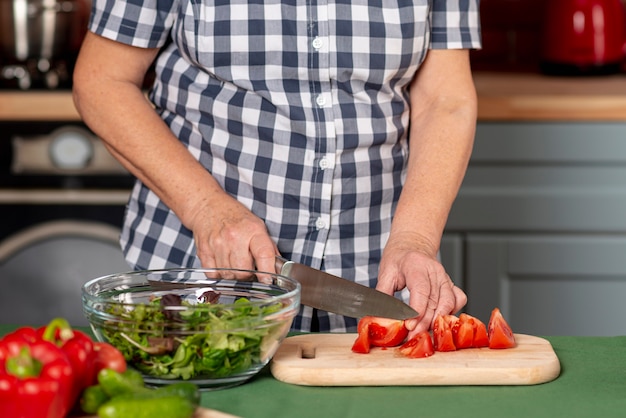There's something undeniably comforting about a big pot of simmering collard greens. The aroma alone is enough to transport you to a warm, inviting kitchen, filled with the laughter and love of family gatherings. But let's be honest, achieving that perfect tenderness, that melt-in-your-mouth texture, can be a bit of a challenge. You don't want tough, chewy greens, but you also don't want them overcooked and mushy. Finding that sweet spot is key, and that's precisely what I'm going to help you achieve today.
My journey with collard greens began in my grandmother's kitchen. She had a knack for whipping up the most incredible batches of greens, and I spent countless hours watching her work her magic. It wasn't until I started cooking them myself that I realized there was a whole science to it, a delicate balance of timing, technique, and seasoning that made all the difference.
Through trial and error (and some less-than-perfect batches), I've finally mastered the art of cooking tender, flavourful collard greens. In this article, I'll share everything I've learned, from the importance of choosing the right greens to the secrets of the perfect simmer. You'll discover exactly how long to cook them for that ultimate tenderness, along with my favourite tips and tricks that will elevate your collard greens from ordinary to extraordinary. So, grab a pot, your favourite seasonings, and get ready to unlock the secrets to the most delicious collard greens you've ever had.
(Part 1) Selecting the Perfect Greens: A Foundation for Success

The journey to perfect collard greens starts long before you even reach for a pot. Choosing the right greens is like laying the foundation of a house – if it's shaky, the whole structure suffers. So, pay attention to these key factors when selecting your collard greens:
1. Freshness is Key
Freshness is paramount when it comes to leafy greens. Look for collard greens that are vibrant green, with leaves that are firm and free from any signs of wilting or browning. Avoid those with yellowing leaves or stems that feel soft and mushy – these are signs that the greens are past their prime and won't offer the same flavour or texture.
2. Size Matters: A Symphony of Even Cooking
While it might seem like bigger is always better, the size of the leaves plays a crucial role in achieving consistent tenderness. When choosing your greens, look for leaves that are relatively similar in size. This ensures they cook evenly, preventing some leaves from becoming overly soft while others remain tough.
3. Don't Neglect the Stems: A Source of Flavour
The stems of collard greens are often overlooked, but they actually contribute a surprising amount of flavour. Choose greens with stems that are relatively thin and not overly fibrous. These stems will be easier to cook and less likely to end up tough and chewy in your final dish.
(Part 2) The Importance of Washing and Preparing: Setting the Stage

Once you've secured those beautiful, fresh collard greens, it's time to give them a good wash and prep them for cooking. Think of this as prepping the stage for a performance – you want everything in place to ensure a smooth and delicious outcome.
1. A Thorough Wash: Removing the Unwanted
Dirt and debris can easily hide among the leaves, so a thorough wash is essential. Start by separating the leaves and discarding any that are damaged or wilted. Fill a large bowl with cold water and add the leaves. Gently swish them around, making sure to remove any dirt or grit. You can repeat this process a couple of times if necessary.
2. The Trim: Unveiling the Tenderness
Now, it's time to trim those tough stems. Cut them off about an inch from the base of the leaf, leaving the tender leaves intact. For smaller leaves, you can simply discard the entire stem. For larger leaves, remove the thicker part of the stem and leave the thinner, more tender portion attached.
3. The Chop: A Matter of Preference
After trimming the stems, it's time to chop those leaves. How you chop them is entirely up to your personal preference. Some people prefer finely chopped greens, while others like larger pieces. I recommend chopping the leaves into roughly 1-2 inch pieces. This ensures they cook evenly and won't become mushy.
(Part 3) The Art of the Simmer: The Transformation Begins

With your collard greens prepped and ready, the simmering process begins. This is where the magic happens, where the tough leaves slowly transform into tender, delicious goodness. Here's my foolproof method for achieving that perfect texture.
1. The Pot and the Liquid: The Foundation of Flavor
Start by filling a large, heavy-bottomed pot with about 4 cups of water or broth. I prefer to use chicken broth for an extra layer of flavour, but you can use vegetable broth or even water if you prefer. Add a pinch of salt to the liquid – this not only enhances the taste but also prevents the greens from becoming bland.
2. The Greens: Submerge and Simmer
Once the liquid is simmering, gently add the chopped collard greens to the pot. Stir them to ensure they're completely submerged in the liquid. Cover the pot with a lid and reduce the heat to a low simmer. The slow, gentle heat is crucial for tenderising the greens without overcooking them.
3. The Patience Game: Time for Tenderness
This is where patience truly comes into play. Collard greens need time to break down and become tender. The exact cooking time will vary depending on the size of the leaves, but it's best to cook them for at least 30 minutes, and possibly up to an hour, for the best results.
4. Checking for Tenderness: The Test of a Fork
After about 30 minutes, start checking for tenderness. Use a fork to pierce a few of the leaves. If they're easily pierced and have softened considerably, they're ready. If they're still tough, continue cooking for another 10-15 minutes. Remember, patience is key to unlocking that melt-in-your-mouth texture.
(Part 4) Flavour Infusion: A Symphony of Seasonings
While your collard greens are simmering, it's time to add your favourite seasonings. This is your chance to unleash your creativity and create a flavour profile that's uniquely your own.
1. The Classics: Building a Flavor Base
Some classic seasonings that pair beautifully with collard greens include salt, pepper, garlic powder, onion powder, and smoked paprika. These seasonings will enhance the natural flavours of the greens, creating a rich and savoury base that you can build upon.
2. A Dash of Heat: A Touch of Zing
For a touch of heat, add a pinch of cayenne pepper or red pepper flakes. A little goes a long way, so start with a small amount and adjust to your preferred level of spiciness. You want to add a subtle kick, not overpower the delicate flavour of the greens.
3. The Smoky Touch: Depth and Complexity
If you're a fan of smoky flavours, add a teaspoon or two of liquid smoke. This will give your collard greens a depth of flavour that's truly irresistible, adding a hint of campfire magic to your dish.
4. Other Options: Experiment and Discover
Don't be afraid to experiment with other seasonings. A sprinkle of dried herbs like thyme, rosemary, or sage can add a complex dimension to your greens. You can also introduce a touch of sweetness with a tablespoon of molasses or brown sugar, adding a subtle sweetness that complements the savoury notes.
(Part 5) The Finish Line: Polishing the Masterpiece
Once your collard greens are tender and seasoned to your liking, it's time to give them a final touch, a few finishing touches that will elevate them from good to truly exceptional.
1. The Stir: A Final Blend
Start by giving the greens a good stir, ensuring that all the seasonings are evenly distributed throughout the pot. This ensures a consistent flavour in every bite.
2. The Taste Test: Your Personal Touch
Now, it's time for the most important step: the taste test. Take a spoonful and evaluate the flavours. Adjust the seasonings as needed, adding more salt, pepper, or other spices to your preference. This is your opportunity to make the greens truly your own.
3. The Finishing Touches: Enhancement and Refinement
For a creamy texture, consider adding a tablespoon or two of butter or olive oil. This will enhance the richness of the greens and create a smooth, velvety mouthfeel, making them even more satisfying.
To balance the richness and add a refreshing tangy flavour, squeeze a lemon wedge or add a tablespoon of apple cider vinegar. This adds a touch of acidity, creating a more complex flavour profile.
(Part 6) Serving Suggestions: A Culinary Canvas
tender collard greens are incredibly versatile and can be enjoyed in a variety of ways. They're a blank canvas, ready for you to paint your own culinary masterpiece.
1. The Classic side dish: A Southern Tradition
Serve them as a traditional Southern side dish alongside your favourite barbecue, fried chicken, or other hearty meals. Their rich, earthy flavour complements a wide range of dishes, adding a comforting touch to any meal.
2. A Hearty Soup: A Warm and Nourishing Meal
Add them to a pot of soup for a nutritious and flavourful meal. They pair well with black-eyed peas, ham hocks, or chicken broth, adding a unique texture and depth of flavour to your soup.
3. A Filling Salad: A Burst of Texture and Flavor
Mix them into a salad for a healthy and satisfying lunch or dinner. They add a nice crunch and a unique flavour to salads, balancing the lighter elements with their heartier texture and flavour.
4. A Veggie Burger Topping: A Delicious Enhancement
Use them as a topping for veggie burgers or sandwiches for a burst of flavour and texture. Their earthy notes and hearty texture complement the meaty flavours of veggie burgers and add a satisfying layer to sandwiches.
(Part 7) Storage and Reheating: Preserving the Goodness
Once you've made a batch of perfect collard greens, you'll want to enjoy them for as long as possible. Here's how to store and reheat them properly to maintain their flavour and texture.
1. Storage: Keeping the Flavour Fresh
To store your cooked collard greens, transfer them to an airtight container and refrigerate for up to 3-4 days. Make sure the container is tightly sealed to prevent any unwanted flavours from mingling with your greens.
2. Reheating: Bringing Back the Warmth
When you're ready to enjoy them again, you can reheat them on the stovetop over low heat or in the microwave. Add a tablespoon or two of water or broth to the greens while reheating to prevent them from drying out. Stir them occasionally to ensure even heating.
(Part 8) FAQs: Addressing Common Concerns
1. Can I use frozen collard greens instead of fresh?
Yes, you can use frozen collard greens. However, they may need to be cooked for a slightly longer time to achieve tenderness. Follow the instructions on the package for the best results. You might also find that frozen greens release more moisture during cooking, so you may need to adjust the liquid levels in your pot accordingly.
2. What if my collard greens are still tough after an hour of cooking?
If your collard greens are still tough after an hour of cooking, they may have been overcooked, leading to a dry, tough texture. This can happen if the liquid has boiled away, leaving the greens dry. To fix this, add more water or broth to the pot and continue cooking for another 15-20 minutes, ensuring the greens are adequately rehydrated.
3. Can I add other ingredients to my collard greens?
Absolutely! Collard greens are incredibly versatile and can be cooked with a variety of ingredients. Some popular additions include ham hocks, bacon, smoked sausage, onions, garlic, and potatoes. These ingredients add extra flavour, texture, and richness to your collard greens, creating a truly satisfying meal.
4. What if I don't have a heavy-bottomed pot?
If you don't have a heavy-bottomed pot, you can use a regular pot. Just make sure to monitor the greens carefully and add more liquid as needed to prevent them from sticking to the bottom of the pot. Stir them regularly to ensure even cooking and prevent any burning.
5. Are collard greens good for you?
Yes, collard greens are packed with nutrients. They're a good source of vitamins A, C, and K, as well as fiber, calcium, and iron. They're also low in calories and fat, making them a healthy and delicious addition to your diet.
(Part 9) Conclusion: Embrace the Journey
cooking collard greens to perfect tenderness is an art form, a journey of patience and experimentation. But with a little practice and the right techniques, you'll be on your way to creating the most delicious and tender collard greens you've ever tasted. So, embrace the journey, get cooking, and enjoy the delicious results.
Everyone is watching

Corn on the Cob: The Ultimate Guide to Perfectly Cooked Ears
Healthy MealsAh, corn on the cob. Just the name evokes images of sunny days, barbecues, and that sweet, juicy flavour that ...

Perfect Pork Roast Oven Cooking Time: A Guide to Delicious Results
Healthy MealsThere's something truly satisfying about a perfectly roasted pork. The aroma alone is enough to make your mout...

Ham Cooking Time: How Long to Bake, Smoke, or Boil a Delicious Ham
Healthy MealsAh, ham. It's a classic, isn't it? A real crowd-pleaser, especially around holidays. And when done right, it'...

Scallops: The Ultimate Guide to Perfect Cooking
Healthy MealsAh, scallops. Those delicate, sweet, and utterly delicious morsels of the sea. They hold a special place in my...

Spaghetti Squash: The Ultimate Guide to Cooking and Serving
Healthy MealsRemember that time you saw spaghetti squash at the supermarket, looking all bumpy and strange, and thought, "W...
